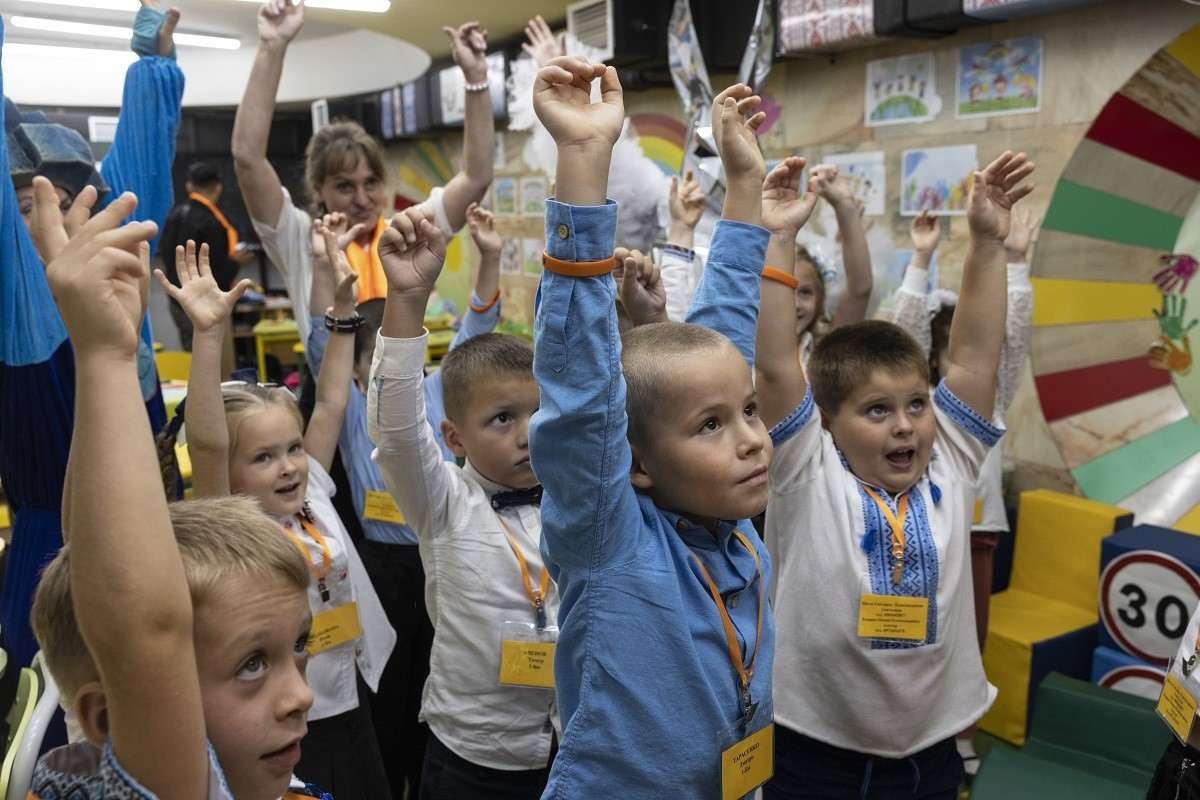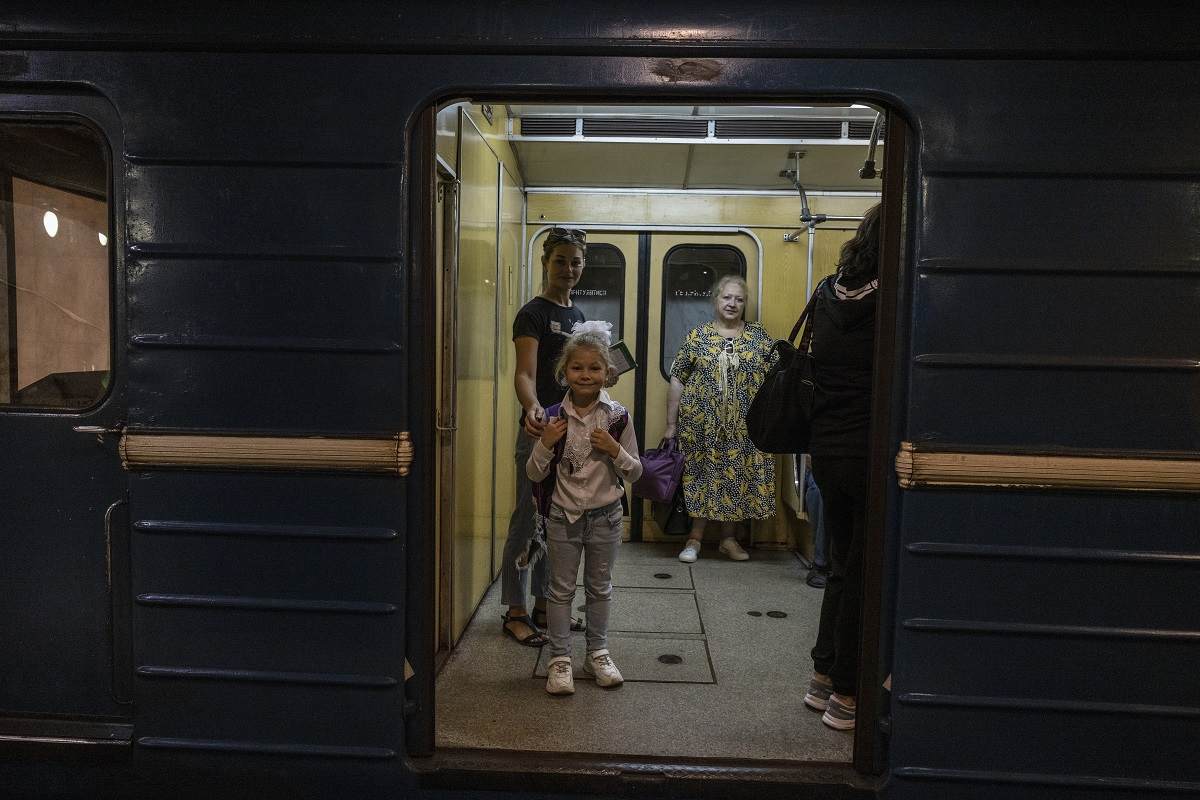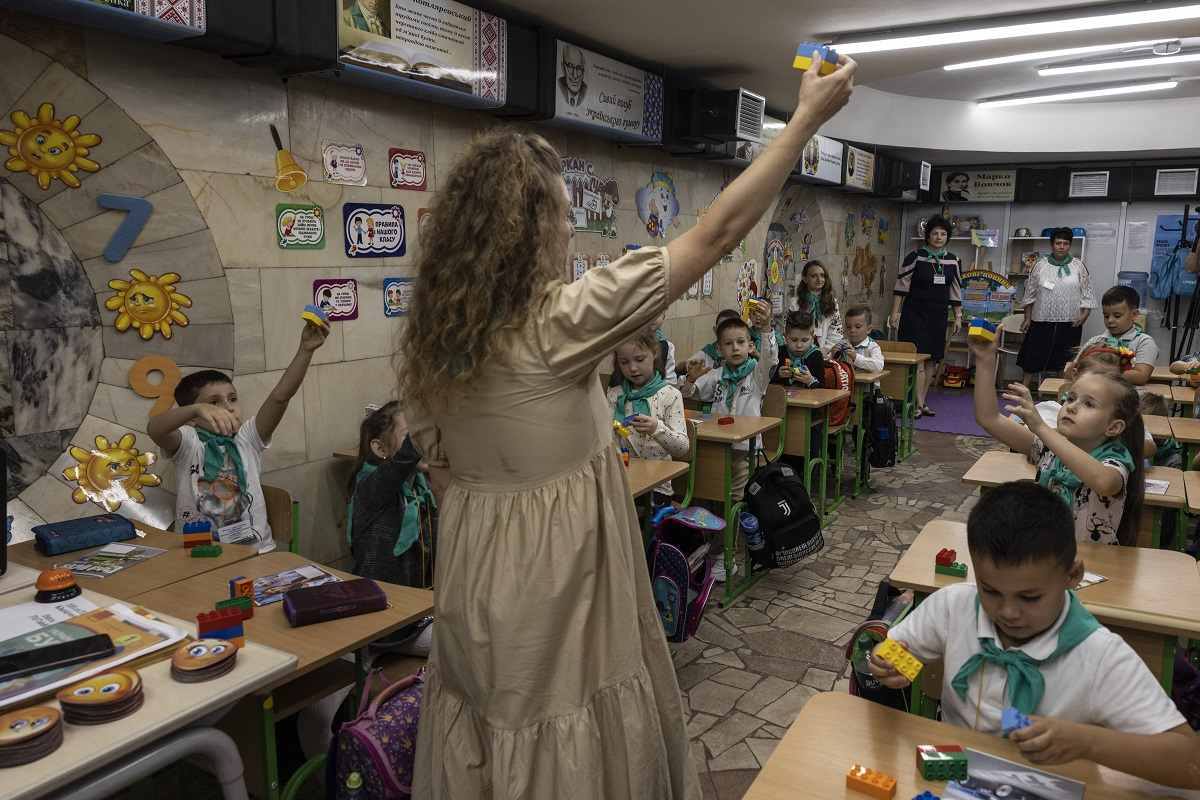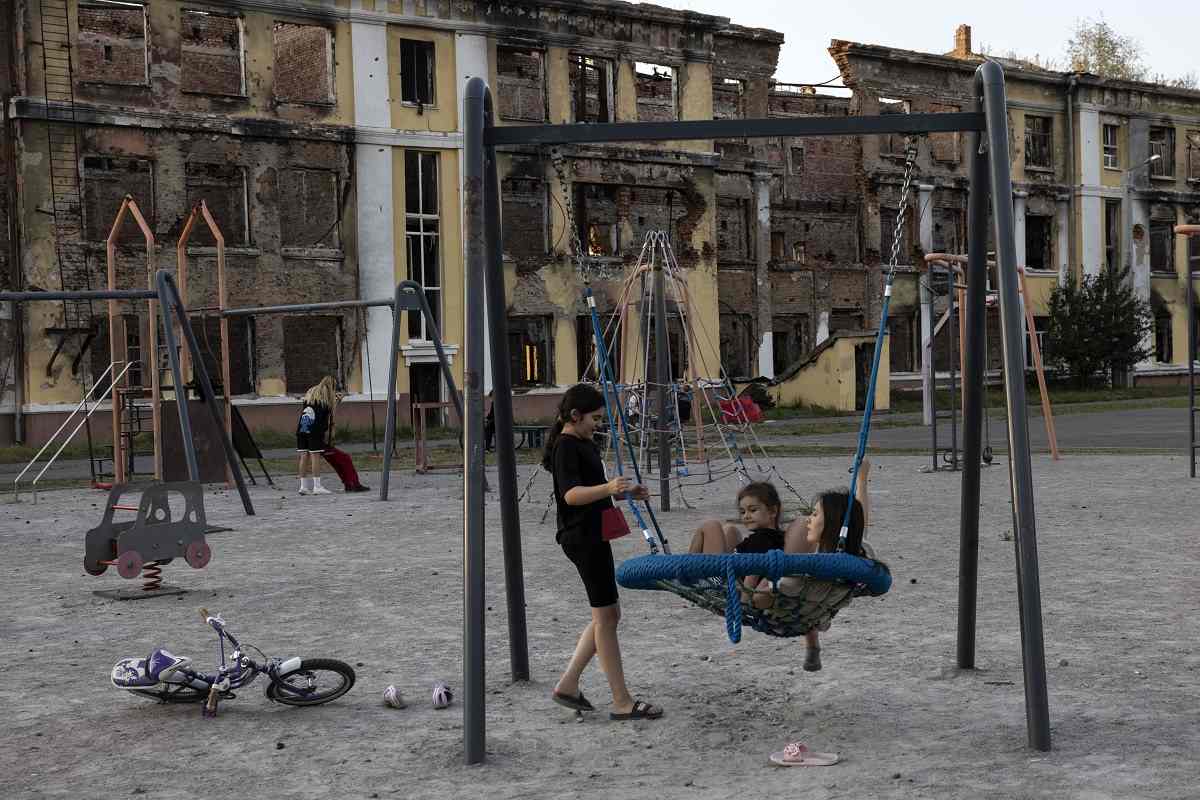

Top: Mothers welcome their children coming out of school on the first day of classes held in the underground metro station in Kharkiv, Ukraine, on Monday.
Bottom: First-grade students during their first day of school held in a newly built classroom in the underground metro station in Kharkiv, Ukraine.
13:27 JST, September 6, 2023
KHARKIV, Ukraine – The first-graders gathered to start a new school year in a windowless underground hallway turned classroom, gushing about the best things in the whole world.
A girl with a green handkerchief tied neatly around her neck held the yarn. It’s the talking yarn – meaning she had the floor. “My name is Nastia. I like chocolate,” she said. The students clapped. She passed the yarn to a boy.
“My name is Vlad,” he said. “I like sports and games.” More applause.
“Now we know Vlad likes sports,” the teacher told the class. “Who is next?”
Monday marked the first day of classes for students in Kharkiv, Ukraine’s second biggest city, located just 25 miles from the Russian border. It was also the 558th day of Russia’s continuing invasion and, to protect the children from the constant threat of airstrikes, makeshift classrooms have been set up throughout the city’s sprawling subway system.
More than 1,300 schools in areas controlled by the Ukrainian government have been destroyed since start of the invasion in February 2022, according to UNICEF, which has documented profound learning loss among Ukrainian children after their safe environments were obliterated.
In Kharkiv, where the launch and impact of missiles from Russian soil are measured in seconds, online classes are now the norm. So officials here launched a voluntary initiative for parents and students who want to learn in a physical classroom to supplement computer-based learning while offering hardened shelter from the bombs.
The setting may have been unfamiliar, but typical first day rituals played out all morning, albeit with the occasional commuter shuffling past. Emotional parents took proud photos on their cellphones before sending the children off, teachers corralled their students into lesson plans, and shy kids met their soon- to-be best friends. Many students wore vyshyvankas – crisp white shirts with traditional embroidered designs.
Parents and teachers on hand for the first day of school said the program was a welcome creation, allowing children to have a semblance of a normal education and social interaction with other students, even as Russian and Ukrainian troops fight pitched battles in the region.
About 1,000 students have signed up so far, said Kharkiv Mayor Ihor Terekhov, who said he was not aware of other programs like it in Ukraine. The number amounts to less than one percent of Kharkiv’s roughly 112,000 schoolchildren but national polling suggests that roughly 20 percent of parents want in-person classes and, in Kharkiv, Terekhov said he expects enrollment to grow.
“Children don’t have an opportunity to study in their usual schools,” he said in the Freedom Square subway station, as a class learned about shapes. “They need to be socialized.”
The subway station school facilities included bathrooms and air ducts. In the rear of a hallway, nurses stood ready to help with scraped knees and runny noses. And psychologists quietly observe the students.
Many families displaced from front line areas have found refuge in Kharkiv, where more than 18 months of war nonetheless have put children under extended duress.
Nadia Kozyreva, a single mother and her twin 6-year old girls, left their hometown of Kupyansk last September after it was liberated. The Russians had occupied it for six months, and the town was relentlessly shelled in the fight to reclaim it. It is still being attacked daily, she said, as Russians fight to recapture ground nearby. Residents who had stayed or returned after fleeing last year were ordered to evacuate last month.
Kozyreva’s daughters – Victoria, calm and contemplative, and Kateryna, a frenetic ball of energy – still ask to go home, but she has told them it is still not safe. The girls are now enrolled in the program for at least a year, she said. They emerged from the underground classroom happy, she said, to experience something different.
The program is a boon at the right moment, Kozyreva said. On her janitor’s salary, she has found it hard to pay for the computer equipment needed for online lessons, and she has struggled herself with the technology.
“I’m a simple girl,” she said, “from a village.”
A scrum of doting mothers awaited their sons and daughters to emerge from their first lessons inside the Peremoha – or “Victory” – metro station in northwest Kharkiv. The parents there said they were relieved to see their children begin their education with some normalcy after last year’s widespread disruptions. They are not allowed to go outside during recess, one parent said, so the educators have found solutions to keep children engaged with games throughout the day.
Bohdana Boholiubova, with her husband at her side and an infant strapped in a carrier on her chest, explained the turmoil that led to this moment. Her family fled Kharkiv last year for the relative calm in the western city of Lviv. They returned last fall following the region’s liberation.
The program shows promise, but it will depend on the attitude of the students and parents to ensure the children are well served, Boholiubova said.
That could be difficult in war, Boholiubova said, but her 7-year old daughter Sonia and the rest of the family have adjusted to a new normal. Getting Sonia into a classroom, whether in a traditional school building or a subway, is crucial, Boholiubova said.
“It’s better than online,” she said, while waiting for Sonia at pickup on Monday. “She can speak with children.”
The children burst through the metro tunnel with ice-creams in hand, and the Boholiubova family reunited.
Elsewhere in the mob, Ira Kravchenko embraced her 6-year old daughter Nicole, who delivered an initial review of her subway-school experience: thumbs up.
Kravchenko has empowered her daughter to decide if she stays in the program. For now, the setup allows Kravchenko to run errands during the day, rather than keeping Nicole at home. And the added protection of her daughter spending time underground has provided some peace of mind.
“She is going to be safe here,” Kravchenko said, before leading Nicole in hand to board a train inside her school.

Ira Kravchenko, 36, and her daughter Nicole, 6, as they wait on a train after the first day of classes held in the underground metro station in Kharkiv, Ukraine.
Above ground, where students filtered out of the Freedom Square station, they were greeted with air raid sirens echoing throughout the city – a sound that has come to define their young lives with such normalcy that few even seemed to notice.
Deeper underground, where the sirens cannot be heard, the buzz of excited students and energetic teachers was the primary sound in the narrow classrooms, where quotes from prominent Ukrainians throughout history were displayed on the walls next to bright color drawings.
Hanna Neelova, a first-grade teacher, commanded the enraptured attention of a class that had never quite experienced education in the flesh. The war has brought grief for children since last year, she said, with many of whom need psychological help to understand what was happening around them.

Hanna Neelova, 43, teaches her first-grade students in one of the many classrooms that have been built in Kharkiv’s underground metro to protect the students from Russian missiles.
Teaching is a calling, Neelova said, and the new setup is not just a benefit for students. Being in the same room with her students, rather than on a screen, has restored her own vitality, she said.
“It’s nice to feel the energy from the kids,” Neelova said. “We didn’t feel that for the last year and a half.”

Children on the playground of School No. 134 in Kharkiv, Ukraine, on Monday.
"News Services" POPULAR ARTICLE
-

American Playwright Jeremy O. Harris Arrested in Japan on Alleged Drug Smuggling
-

Japan’s Nikkei Stock Average as JGB Yields, Yen Rise on Rate-Hike Bets
-

Japan’s Nikkei Stock Average Licks Wounds after Selloff Sparked by BOJ Hike Bets (UPDATE 1)
-

Japanese Bond Yields Zoom, Stocks Slide as Rate Hike Looms
-

Japan’s Nikkei Stock Average Buoyed by Stable Yen; SoftBank’s Slide Caps Gains (UPDATE 1)
JN ACCESS RANKING
-

Keidanren Chairman Yoshinobu Tsutsui Visits Kashiwazaki-Kariwa Nuclear Power Plant; Inspects New Emergency Safety System
-

Imports of Rare Earths from China Facing Delays, May Be Caused by Deterioration of Japan-China Relations
-

University of Tokyo Professor Discusses Japanese Economic Security in Interview Ahead of Forum
-

Japan Pulls out of Vietnam Nuclear Project, Complicating Hanoi’s Power Plans
-

Govt Aims to Expand NISA Program Lineup, Abolish Age Restriction





















